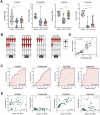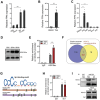Butyrate Prevents the Pathogenic Anemia-Inflammation Circuit by Facilitating Macrophage Iron Export
- PMID: 38235606
- PMCID: PMC10966513
- DOI: 10.1002/advs.202306571
Butyrate Prevents the Pathogenic Anemia-Inflammation Circuit by Facilitating Macrophage Iron Export
Abstract
Most patients with inflammatory bowel disease (IBD) develop anemia, which is attributed to the dysregulation of iron metabolism. Reciprocally, impaired iron homeostasis also aggravates inflammation. How this iron-mediated, pathogenic anemia-inflammation crosstalk is regulated in the gut remains elusive. Herein, it is for the first time revealed that anemic IBD patients exhibit impaired production of short-chain fatty acids (SCFAs), particularly butyrate. Butyrate supplementation restores iron metabolism in multiple anemia models. Mechanistically, butyrate upregulates ferroportin (FPN) expression in macrophages by reducing the enrichment of histone deacetylase (HDAC) at the Slc40a1 promoter, thereby facilitating iron export. By preventing iron sequestration, butyrate not only mitigates colitis-induced anemia but also reduces TNF-α production in macrophages. Consistently, macrophage-conditional FPN knockout mice exhibit more severe anemia and inflammation. Finally, it is revealed that macrophage iron overload impairs the therapeutic effectiveness of anti-TNF-α antibodies in colitis, which can be reversed by butyrate supplementation. Hence, this study uncovers the pivotal role of butyrate in preventing the pathogenic circuit between anemia and inflammation.
Keywords: anemia; butyrate; ferroportin; inflammatory bowel disease; macrophages.
© 2024 The Authors. Advanced Science published by Wiley‐VCH GmbH.
Conflict of interest statement
The authors declare no conflict of interest.
Figures








References
-
- a) Winn N. C., Volk K. M., Hasty A. H., JCI Insight 2020, 5, e132964; - PMC - PubMed
- b) Sukhbaatar N., Weichhart T., Pharmaceuticals 2018, 11, 137; - PMC - PubMed
- c) Zhang Z., Zhang F., An P., Guo X., Shen Y., Tao Y., Wu Q., Zhang Y., Yu Y., Ning B., Nie G., Knutson M. D., Anderson G. J., Wang F., Blood 2011, 118, 1912; - PubMed
- d) Canny S. P., Orozco S. L., Thulin N. K., Hamerman J. A., Annu. Rev. Immunol. 2023, 41, 405,. - PMC - PubMed
-
- a) Li J.‐Y., Yu M., Pal S., Tyagi A. M., Dar H., Adams J., Weitzmann M. N., Jones R. M., Pacifici R., J. Clin. Invest. 2020, 130, 1767; - PMC - PubMed
- b) Tyagi A. M., Yu M., Darby T. M., Vaccaro C., Li J.‐Y., Owens J. A., Hsu E., Adams J., Weitzmann M. N., Jones R. M., Pacifici R., Immunity 2018, 49, 1116; - PMC - PubMed
- c) Uribe‐Herranz M., Rafail S., Beghi S., Gil‐De‐Gómez L., Verginadis I., Bittinger K., Pustylnikov S., Pierini S., Perales‐Linares R., Blair I. A., Mesaros C. A., Snyder N. W., Bushman F., Koumenis C., Facciabene A., J. Clin. Invest. 2020, 130, 466. - PMC - PubMed
MeSH terms
Substances
Grants and funding
- 2021KY749 2023KY804/Medical Science and Technology Project of Zhejiang Province
- LQ21H030013/Natural Science Foundation of Zhejiang Province
- 82171730/National Natural Science Foundation of China
- 81970484/National Natural Science Foundation of China
- 82100540/National Natural Science Foundation of China
LinkOut - more resources
Full Text Sources
Medical
